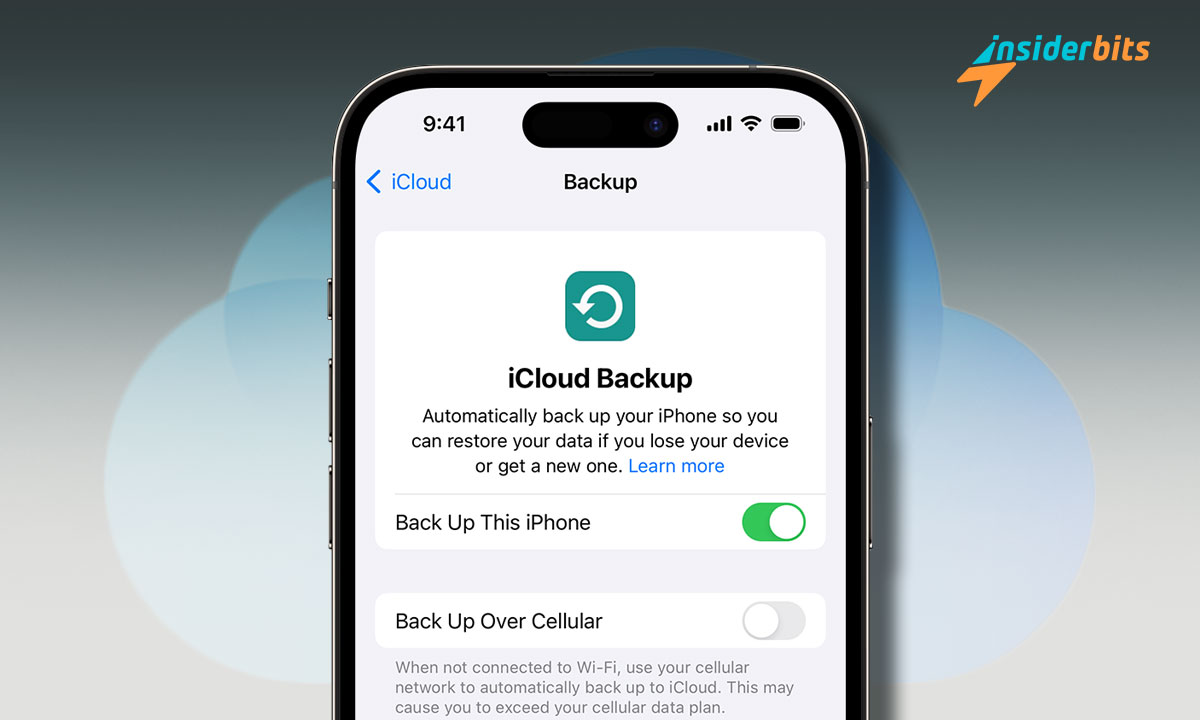Keeping your data secure is made easy with an iCloud backup, but knowing how to manage it properly might not seem as straightforward at first glance.
This tutorial by Insiderbits will guide you through understanding your iPhone backup, showing you detailed steps to guarantee your data’s safety and accessibility.
Curious about how to leverage iCloud’s features fully? Then keep reading our detailed guide and become adept at handling your backups like a pro, ensuring peace of mind.
Related: How to Make the Best Out of Siri?
iCloud Unveiled: A Simple Functionality Guide
Have you ever wondered how all your photos, contacts, and documents stay synchronized across your devices? iCloud makes this magic happen, seamlessly connecting your digital life.
iCloud backup is an essential tool, quietly working in the background to store your data safely in Apple’s cloud servers, ready to be accessed anytime you need.
To securely back up your iPhone, iCloud offers a simple solution that automatically saves your information while you sleep, ensuring you never lose your important memories.
Imagine switching phones and finding all your apps, messages, and settings just as you left them. iCloud makes this transition smooth and hassle-free for everyone.
Finding Your Way Around iCloud Settings
Before you can make the most of iCloud’s features, it’s important to know where your settings are located. Accessing them is the first step to using this resource to its fullest.
- To locate your backup settings, start by unlocking your iPhone and tapping the “Settings” icon, which you can find on your home screen or in a utility folder.
- Once you’re in the “Settings” app, tap on your name at the top, which leads you to your Apple ID menu. From there, select “iCloud” to manage your configurations
- In the iCloud menu, scroll down to find the “iCloud Backup” option. Here, you can check whether backups are active and manage them properly.
- To ensure your iPhone backup is always current, toggle the iCloud switch to the green “on” position if it isn’t already. This automates the backup process.
With these steps, you can easily confirm that your iCloud backup settings are working correctly, ensuring your iPhone data is securely stored and always recoverable.
Related: How To Connect Your Apple Devices – A Comprehensive Guide
Best Practices for iCloud Management
Managing your iCloud settings is straightforward. With just a few taps, you can access and adjust your preferences, ensuring your digital life is organized and secure.
- Select “iCloud” from the Apple ID overview to delve into the specifics of your cloud storage and services.
- Tap on “Manage Storage” to see how much space each app and service is using, and make adjustments as needed.
- Check the “iCloud Backup” section to view the details of what is included in your backups.
- Beneath the storage and backup options, you’ll find a list of apps using iCloud. Toggle each app to manage whether its data is synced to it.
- Ensure that your essentials like contacts, calendars, and reminders are syncing correctly by managing these settings under their sections.
- iCloud Keychain keeps your passwords and credit card information secure and accessible across devices. You can turn it on or off and manage its settings here.
Checking Your Backup Status
Reviewing your backup status on iCloud is equally simple. Navigate to the iCloud settings, and with one glance, you can see when your last successful backup occurred.
- From your Apple ID menu, choose the “iCloud” option to view its services and settings. Scroll down to find and select “iCloud Backup” to view the current backup settings.
- Check the status here to see the date and time of your last successful iPhone backup. This information is displayed at the top of the menu.
- If your last backup was not recent or if you need a new one, you can tap “Back Up Now” to start the process immediately.
- Make sure your device remains connected to Wi-Fi during this process, as it may take some time depending on the data size.
- You can check the progress of the backup directly in the iCloud settings. A status bar will indicate how the backup is progressing.
- Once the backup is complete, the date and time of this latest backup will update, confirming that your data is securely stored in iCloud.
Related: How to share the Internet from an iPhone without an access point?
Testing the Waters: How to Safely Simulate a Data Restore
If you’re considering a new iPhone or have one ready, it’s the perfect opportunity to test your iCloud backup by restoring it to the new device.
Using your new phone to test the restoration helps ensure that all critical data from your previous device, safeguarded by an iPhone backup, seamlessly transitions without any hitches.
This also lets you experience the setup process, seeing that all applications, settings, and contents are exactly where they should be. It’s like meeting an old friend in a new place.
However, before starting this process, confirm that your most recent data is included in the last backup. This will guarantee that you are restoring the most current version of your data.
- Before you begin, see if your iPhone is fully charged or connected to a power source to prevent interruptions during the restoration process.
- Access “Settings”, proceed to “General”, and select “Reset”. Tap on “Erase All Content and Settings”. This action is necessary to enable restoration from an iCloud backup.
- Once your iPhone restarts, proceed with the on-screen setup instructions until you arrive at the “Apps & Data” screen.
- Pick “Restore from iCloud Backup” from the list of options. This action will begin the restoration of your iPhone from the specified backup.
- Enter your Apple ID and password to access your iCloud account. This is crucial as it links to the backup you intend to restore.
- Pick the latest or suitable backup from the available options. Confirm its accuracy by looking at the date and size details.
- Once you select the backup, the restore process will begin. The time it takes can vary significantly based on the size of the backup and your internet speed.
- Once setup is complete, verify that all desired content, such as contacts, photos, apps, and settings, has been properly restored to your iPhone.
Related: How To Find A Network Security Key On An iPhone?
Concluding Steps to Secure Your iPhone Backup
Learning about iCloud backup empowers you to manage your data with assurance. It’s comforting to know that your digital life is protected and accessible whenever you need it.
Navigating through iCloud settings now feels much simpler, and securing your data is just a few taps away. Each step we covered increases your confidence in handling personal information.
Insiderbits brought you this tutorial to streamline your iPhone backup process, making sure that you’re well-prepared to safeguard your mobile data using this effective cloud service.
Looking for more? Keep learning with us at Insiderbits. Discover more practical guides and articles that empower you to take full control of your technology with our help.





